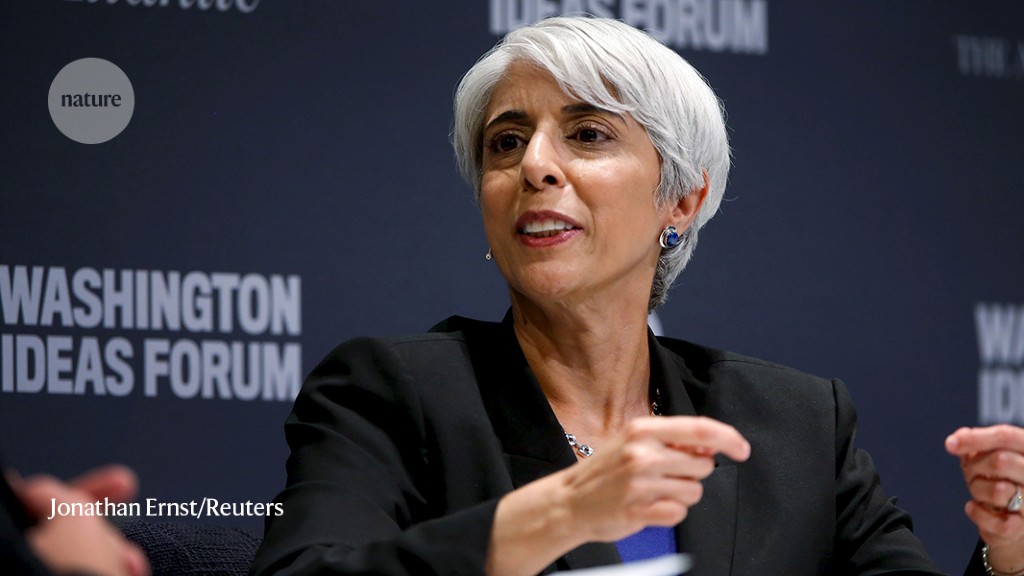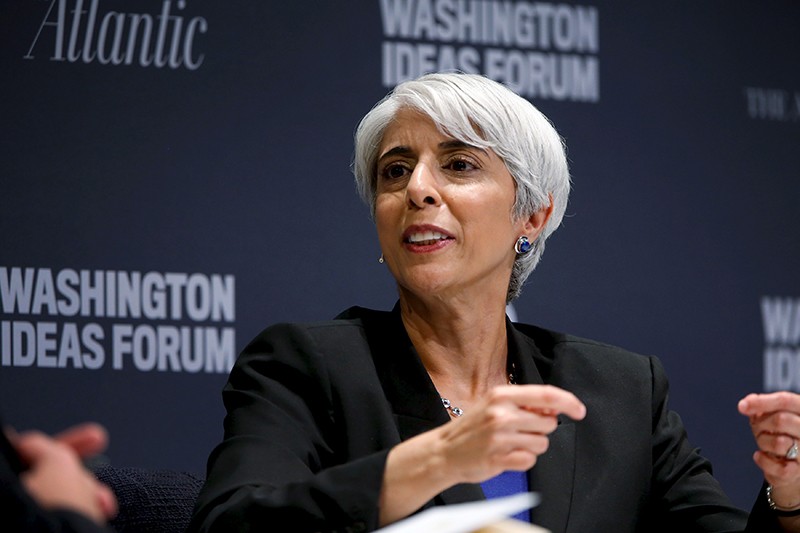US President Joe Biden has nominated Arati Prabhakar, an applied physicist with extensive experience in both government and the private sector, to be head of the White House Office of Science and Technology Policy (OSTP), and named her as his next science adviser. The appointment comes four months after the controversial departure of Biden’s previous science adviser, geneticist Eric Lander. It is a crucial moment, as the Biden administration seeks to advance its agenda on science, innovation and climate.
Biden had tasked Lander, who resigned in February amid accusations of bullying and harassment at the OSTP, with tackling several problems, including how to use lessons from the COVID-19 pandemic to bolster public health, how to drive the development of new technologies in climate and clean energy and how to maintain US scientific leadership while also ensuring that the benefits of innovation flow to all US residents. If her position is confirmed by the Senate, it will be up to Prabhakar to put the agency back on solid footing and carry that agenda forward.
Prabhakar burnished her reputation in Washington DC under two presidents: first as head of the National Institute of Standards and Technology (NIST) from 1993 to 1997 under Bill Clinton, and then as director of the Defense Advanced Research Projects Agency (DARPA) 15 years later, under Barack Obama. In the intervening years, she moved from industry and a privately funded research laboratory to a venture-capital firm, US Venture Partners in Menlo Park, California, where she helped to drive investments in early-stage technologies involving energy, electronics and semiconductors. Under Biden, she will be the first woman and first person of colour to serve as a presidential science adviser.
Scientists contacted by Nature applauded Prabhakar’s nomination, saying her experience and leadership skills would serve the administration well.
“She is a natural leader,” says Neal Lane, a physicist at Rice University in Houston, Texas, who served as director of the US National Science Foundation (NSF) while Prabhakar was at NIST and went on to become Clinton’s science adviser.
Although the position of science adviser does not require Senate confirmation, the role as head of the OSTP does — and that could take months. Since Lander’s departure, sociologist Alondra Nelson has led the OSTP; at the same time, geneticist Francis Collins has been temporarily filling in as science adviser. Previously, Nelson had been serving as deputy director for science and society at the OSTP, a post to which she will now return; Collins stepped down as leader of the US National Institutes of Health in 2021.
One lesson from Lander’s tenure is that behaviour matters, says Rebecca Barnes, a biogeochemist at Colorado College in Colorado Springs, and a leader of 500 Women Scientists, an organization that opposed his appointment as science adviser. And one lesson from Prabhakar’s appointment is that diversity and accomplishment can go hand in hand, Barnes says. “I think it’s important to diversify what a scientist looks like and what a scientist does,” she adds. Prabhakar’s appointment does both, and could help “change the face of science”.
As much as anybody, Prabhakar has what it takes to address any lingering tensions from the Lander era and help the agency move forward, says Margaret Levi, director of the Center for Advanced Study in the Behavioral Sciences at Stanford University in California. “She’s an amazing manager who has dealt with very complex situations in the past.”
Silo breaker
Born in New Delhi and raised in Lubbock, Texas, Prabhakar has led a distinguished career full of firsts, earning respect from scientists in academia and industry. In 1984, she earnt an applied physics PhD at the California Institute of Technology (Caltech) in Pasadena — the first woman to do so. And less than a decade later, she became the first woman to lead NIST, an agency steeped in engineering and physics that focuses on the development of scientific standards and tools.
In 2018, Prabhakar launched her own organization, Actuate, a non-profit think tank based in Palo Alto, California, that seeks to design scientific and policy solutions to global problems such as climate change. After her nomination was announced, the organization released a statement saying that Prabhakar will step down as chief executive once the Senate confirms her as head of the OSTP.
Speaking about scaling up novel energy technologies and policies at a climate seminar at Caltech this month, Prabhakar demonstrated her thinking on how to promote transformational change. One problem in scaling up new technologies is that everybody — from technology and financial firms to government regulators — is operating independently, she said. To solve problems fast enough to make a difference to Earth’s climate requires “breaking out of those silos”, she said.
Levi says that breaking down silos is one of Prabhakar’s talents, and one that will serve her well in her next role. “She’s very engaged with how to make science and technology work to advance public policy on significant societal challenges.”
Challenges ahead
Since taking office last year, Biden has laid out ambitious plans to boost innovation across the federal government and in the private sector. Some parts of his agenda are now moving forward, but others — particularly in the areas of energy and climate — remain mired in a politically deadlocked US Congress. As both science adviser and head of the White House’s core science agency, Prabhakar could have a key role in convening officials across the government and crafting science policies to facilitate progress.
One of the Biden administration’s biggest science initiatives aims to boost innovation in biomedical research by creating the Advanced Research Projects Agency for Health. The agency is being modelled on DARPA, with the goal of promoting risky — but potentially rewarding and transformative — research. To ensure US competitiveness as nations such as China step up their science investments, the administration has also established a new directorate in the NSF, an agency long dedicated to the funding of basic research, that will focus on supporting applied technology.
Biden and his fellow Democrats in Congress have already secured tens of billions of dollars for clean energy and climate initiatives, including an estimated US$22 billion for demonstration projects at the US Department of Energy. But many of Biden’s climate-innovation efforts are tied up in a spending package that remains stalled among legislators.
Michael Lubell, a physicist at the City College of New York who tracks federal science-policy issues, says that Prabhakar is a sound choice for advancing the Biden agenda, which puts a premium on applied science. However, he worries that if the pendulum swings too far in that direction, it could begin to undermine basic research programmes. “She is very good,” he says, “but I’m a little concerned.”
Others see opportunity. Lane says that Prabhakar has a unique background that should allow her to step up to multiple challenges that the United States and the Biden administration are facing. Whether the issue is bringing agencies together to confront climate change, rolling out the new health-innovations agency or confronting questions about research raised by a shifting relationship with China, Prabhakar’s job will be to help build consensus and marshal the troops in a sprawling government apparatus, he says.
“It takes somebody with the personal skills, and the knowledge and the respect that she will have coming into this job,” Lane says.







More News
Editorial Expression of Concern: Leptin stimulates fatty-acid oxidation by activating AMP-activated protein kinase – Nature
Quantum control of a cat qubit with bit-flip times exceeding ten seconds – Nature
Venus water loss is dominated by HCO+ dissociative recombination – Nature